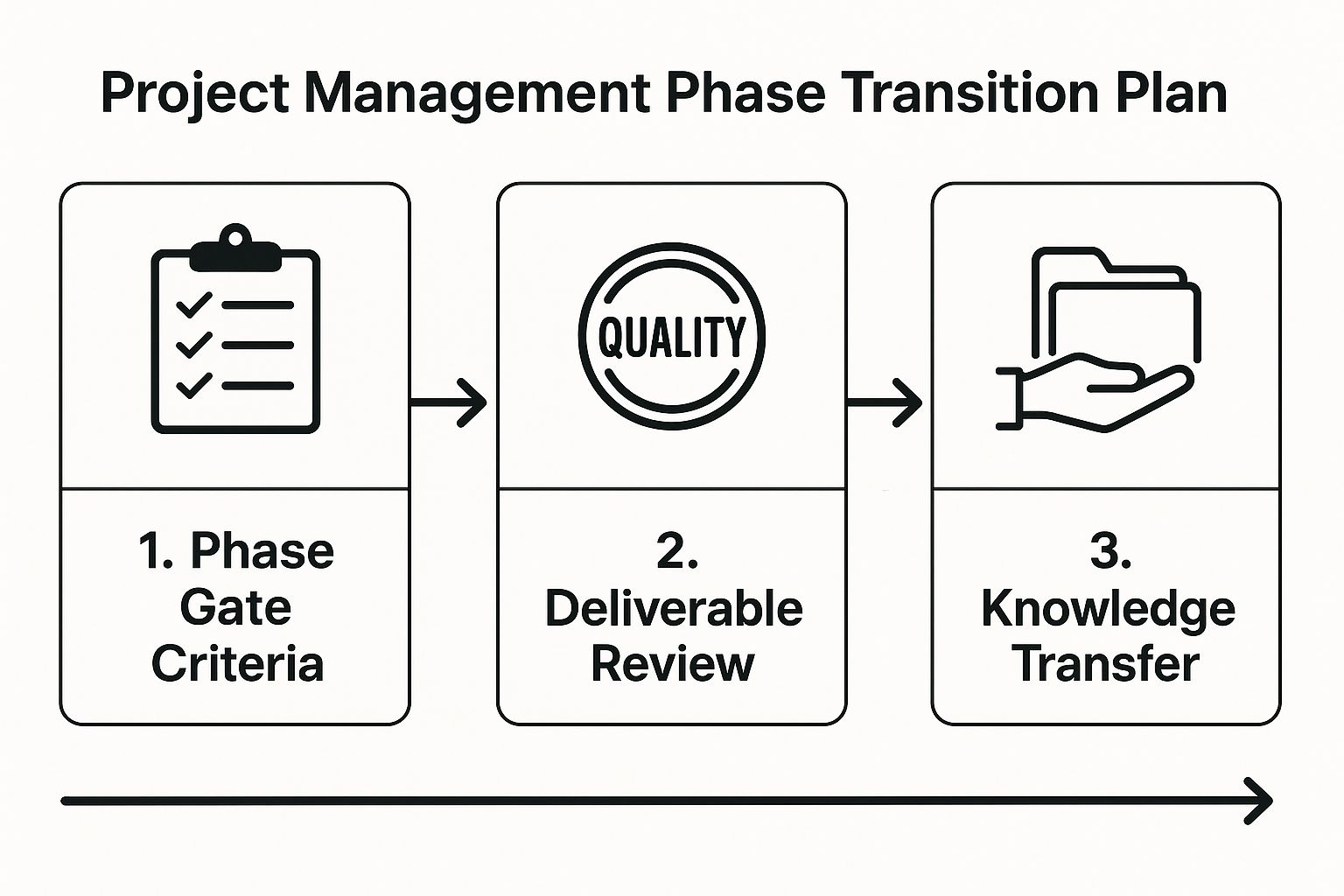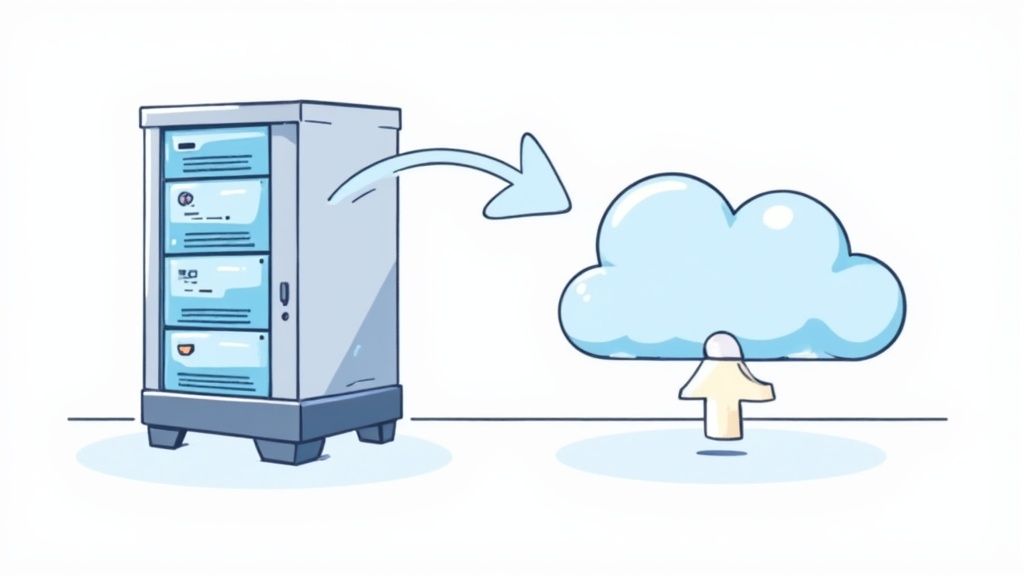Change is inevitable, but chaos is optional. A well-crafted transition plan is the strategic blueprint that separates a seamless evolution from a disruptive crisis. Whether you’re navigating a career shift, managing a complex project handover, or ensuring business continuity, the right plan makes all the difference. It’s more than just a checklist; it’s a detailed roadmap with clear objectives, stakeholder roles, communication protocols, and risk mitigation strategies.
This guide moves beyond theory by dissecting real-world transition plans examples to reveal their core mechanics. We’ll explore diverse scenarios, from individual career changes and executive succession to complex project handovers and technology migrations. For each example, you will find a detailed breakdown of its strategic components, specific tactical insights, and replicable templates you can immediately adapt.
Instead of generic advice, this listicle provides actionable frameworks. You will learn not just what makes these plans effective, but how to apply their principles to your own professional or organizational challenges. Prepare to see precisely how a solid plan acts as the ultimate safety net, ensuring continuity and minimizing friction during periods of significant change. We will cover a range of powerful examples, including:
- Individual Transition Plans (ITP) for Special Education
- Executive Leadership Succession Plans
- Post-Military Career Transition Plans
- Healthcare Patient Discharge Plans
- Project Management Phase Transition Plans
- Technology System Migration Plans
1. Individual Transition Plan (ITP) for Special Education
An Individual Transition Plan (ITP) is a crucial component of an Individualized Education Program (IEP) for students with disabilities. Mandated by the Individuals with Disabilities Education Act (IDEA), this plan outlines the specific steps and services needed to help a student successfully move from high school into post-secondary life, which could include college, vocational training, employment, or independent living. This plan is one of the most structured and impactful transition plans examples because it is person-centered and legally required, ensuring a thoughtful approach to a significant life change.

The ITP process typically begins when the student is between 14 and 16 years old. It involves a collaborative team of educators, counselors, parents, the student, and representatives from external adult service agencies. The core of the ITP is a series of measurable, age-appropriate goals tailored to the student’s unique strengths, preferences, and interests.
Strategic Analysis & Breakdown
The ITP’s strength lies in its long-term, multi-faceted approach. Unlike a standard project plan, it focuses on developing life skills and personal agency alongside academic and vocational competencies. It requires proactive coordination between the school system and external community resources.
Key Strategy: The ITP shifts the focus from purely academic achievement to holistic life-readiness. It mandates that planning for post-school outcomes is not an afterthought but a central part of a student’s education for their final years in the system.
- Goal Alignment: Goals are directly tied to the student’s vision for their future. For instance, a student interested in technology might have goals related to coding classes, internships at a tech company, and learning to use public transportation to get to work.
- Resource Integration: The plan requires schools to connect students with external agencies like vocational rehabilitation or developmental disability services long before graduation, ensuring a seamless handover of support.
Actionable Takeaways & Application
While the ITP is specific to special education, its principles offer valuable lessons for any major transition, including corporate role changes. The core concept of a person-centered, forward-looking plan can be adapted to many scenarios. A structured framework for this can be seen in various business contexts; you can learn more about creating a comprehensive plan for professional transitions.
- Start Early: Begin transition discussions well before a change is imminent. This allows for thorough planning and skill-building.
- Center the Individual: Ensure the person undergoing the transition is the primary driver of the plan. Their goals and preferences should be the foundation.
- Build a Support Network: Identify and engage all relevant stakeholders early. In a corporate setting, this could include the new and old managers, HR, and team members.
- Include Practical Experience: Incorporate hands-on, real-world experiences to test and refine goals, such as job shadowing or a small, supervised project in a new role.
2. Executive Leadership Succession Plan
An Executive Leadership Succession Plan is a high-stakes strategic framework organizations use to ensure seamless leadership continuity. It’s a proactive process for identifying and cultivating internal talent to assume critical leadership roles when they become vacant. This plan is one of the most vital transition plans examples for long-term organizational stability, as it mitigates the risks associated with abrupt leadership changes, such as those from retirement, resignation, or unforeseen circumstances.

This forward-thinking strategy involves a multi-year roadmap for developing high-potential employees. It’s not just about creating a list of names; it’s a comprehensive development program. Renowned examples include Procter & Gamble’s long-standing ‘promote from within’ philosophy and Microsoft’s successful leadership handoffs from Bill Gates to Steve Ballmer and then to Satya Nadella, each managed through deliberate, long-term planning.
Strategic Analysis & Breakdown
The power of a succession plan lies in its integration with the company’s long-term business strategy. It aligns talent development directly with future organizational needs, ensuring that upcoming leaders possess the specific competencies required to navigate future challenges. This approach transforms a potentially chaotic event into a controlled, strategic evolution.
Key Strategy: Succession planning treats leadership development as a continuous, core business function rather than a reactive, HR-driven task. It institutionalizes the process of identifying and nurturing future leaders, making the organization resilient to individual departures.
- Candidate Development: The plan identifies multiple potential successors for each key role and creates tailored development paths. These paths often include cross-functional assignments, mentorship from senior executives, and specific training designed to fill skill gaps.
- Risk Mitigation: By preparing a pool of qualified internal candidates, the organization reduces its reliance on costly and often risky external searches. It also maintains institutional knowledge and cultural continuity.
Actionable Takeaways & Application
While designed for C-suite roles, the principles of succession planning are highly adaptable for ensuring continuity in any critical position, such as a lead developer or project manager. The key is to identify vital roles and proactively prepare for transitions. A critical component of this process is clear communication, which you can refine by reviewing successful internal communication plan examples.
- Plan Years in Advance: Begin identifying and developing potential successors 3-5 years before an anticipated transition.
- Develop a Talent Pool: Avoid betting on a single individual. Cultivate a small group of high-potential candidates for each critical role to foster healthy competition and create a safety net.
- Create High-Pressure Experiences: Test candidates by giving them challenging assignments or leadership of critical projects. This provides real-world insight into their capabilities under pressure.
- Benchmark Internally and Externally: Regularly assess internal candidates against top talent in the external market to ensure your succession choices remain competitive and objective.
3. Post-Military Career Transition Plan
A Post-Military Career Transition Plan is a comprehensive strategy designed to help service members successfully move from active duty to civilian life. This plan is one of the most vital transition plans examples as it addresses the unique cultural, professional, and personal challenges veterans face. It systematically guides them in translating specialized military experience into valuable civilian qualifications, navigating the corporate job market, and aligning their ingrained leadership skills with new career paths.
This process is most effective when initiated 12 to 18 months before separation. It involves leveraging resources like the military’s Transition Assistance Program (TAP), connecting with veteran networking groups, and translating military occupational specialty codes into recognizable job skills. The goal is to create a clear roadmap from a final military assignment to a first civilian role, such as an Army logistics officer becoming a supply chain manager or a Navy nuclear technician transitioning to power plant operations.
Strategic Analysis & Breakdown
The strength of this transition plan lies in its proactive and multi-pronged approach to a profound identity shift. It’s not just about finding a job; it’s about redefining a professional identity for a new environment. The plan requires translating a highly structured, mission-driven background into the more ambiguous and relationship-driven context of the civilian workforce.
Key Strategy: The core strategy is translation and networking. It focuses on methodically deconstructing military roles and achievements into language that civilian hiring managers understand and value, while simultaneously building a new professional network from the ground up.
- Skill Translation: The plan forces a detailed inventory of technical and soft skills. For example, a Marine Corps squad leader’s experience in managing teams under pressure is reframed as “project management,” “crisis leadership,” and “personnel development.”
- Cultural Acclimation: A key component involves learning the nuances of corporate culture, from communication styles to performance metrics. This is often achieved through informational interviews and mentorship from veterans already in the corporate world.
Actionable Takeaways & Application
The principles of a military transition are highly applicable to any significant career pivot, where one must re-brand their expertise for a new industry. Beyond military service, many individuals navigate significant career changes throughout their professional lives. For a broader guide, consider these expert tips for pivoting careers. You can find more structured support in a work transition plan template designed for professional settings.
- Start Well in Advance: Begin planning a major career change at least a year ahead. This provides ample time for research, networking, and upskilling.
- Conduct Informational Interviews: Speak with people who have successfully made a similar transition. Ask about their challenges, what they wish they had known, and how they positioned their past experience.
- Identify and Bridge Skill Gaps: Objectively assess your current skills against the requirements of your target role. Use certifications, courses, or volunteer projects to fill any gaps.
- Build a Targeted Network: Don’t just network broadly. Identify and connect with key individuals and groups within your desired industry or company.
4. Healthcare Patient Discharge Transition Plan
A Healthcare Patient Discharge Transition Plan is a coordinated care strategy designed to ensure the safe and effective movement of patients from a hospital to their next care setting, such as home, a rehabilitation facility, or an assisted living center. This plan is critical for reducing hospital readmissions, improving patient outcomes, and ensuring continuity of care. Popularized by organizations like the Institute for Healthcare Improvement and The Joint Commission, it stands as one of the most vital transition plans examples because it directly impacts patient safety and well-being during a vulnerable period.
This comprehensive plan is developed by a multidisciplinary team including doctors, nurses, social workers, and therapists, in close collaboration with the patient and their family. It details everything from medication management and follow-up appointments to necessary medical equipment and home health services. For example, a post-surgical patient’s plan would coordinate physical therapy sessions, while a heart failure patient’s plan might include home monitoring and specialized nursing visits.
Strategic Analysis & Breakdown
The effectiveness of a patient discharge plan hinges on its proactive and patient-centric nature. It treats the transition not as a single event but as a continuous process that begins at admission and extends beyond the hospital walls. This forward-thinking approach mitigates risks by addressing potential challenges before they become critical incidents.
Key Strategy: The plan’s core strategy is to bridge the communication and care gap between the inpatient hospital setting and the outpatient community. It transforms discharge from a simple administrative task into a robust, hands-on handoff process focused on patient education and empowerment.
- Proactive Planning: Discharge planning is initiated within 24 hours of a patient’s admission, not on the day they are set to leave. This allows ample time to arrange complex services and properly educate the patient and caregivers.
- Multi-Provider Coordination: The plan serves as a central document that aligns care across multiple providers, such as the primary care physician, specialists, pharmacists, and home health agencies, preventing fragmented care. For patients requiring ongoing treatment, a critical component involves outlining strategies for effective post-discharge wound care at home to ensure continuity and prevent readmissions.
Actionable Takeaways & Application
While rooted in healthcare, the principles of a discharge plan can be adapted to manage complex project handoffs or organizational changes. The structured approach to risk mitigation and stakeholder communication is universally applicable. Much like a well-defined medical protocol, businesses can benefit from a clear process for handing off responsibilities; you can discover more about structuring handoffs in an incident management process.
- Use Teach-Back Methods: Confirm understanding by asking the recipient (patient, family member, or colleague) to explain the plan in their own words. This ensures critical information is retained.
- Provide Clear, Written Instructions: Supplement verbal communication with a clear, concise written document that outlines all steps, contacts, and schedules.
- Schedule Proactive Follow-Up: Plan a check-in within a few days of the transition. A follow-up call 48-72 hours after discharge can catch potential issues early.
- Involve All Stakeholders as Partners: Actively include the person transitioning and their support network in the planning process from the very beginning to foster ownership and adherence.
5. Project Management Phase Transition Plan
A Project Management Phase Transition Plan provides a structured framework for moving a project from one distinct stage to the next, such as from design to development or from planning to execution. Popularized by methodologies like the Project Management Institute’s (PMI) PMBOK® Guide and PRINCE2, this plan ensures that each phase is formally closed before the next begins. This process is one of the most critical transition plans examples for ensuring project quality, stakeholder alignment, and resource management, preventing scope creep and resource drain between stages.
A key feature of this transition is the “phase gate” or “gate review,” a formal checkpoint where key stakeholders review deliverables and performance against predefined criteria. This review determines if the project has met the necessary requirements to proceed. For instance, a software project would not move from design to development until the architectural blueprints and user interface mockups are approved at the phase gate.
Strategic Analysis & Breakdown
The strength of a phase transition plan lies in its ability to impose discipline and quality control throughout the project lifecycle. It transforms a potentially chaotic and continuous workflow into a series of manageable, sequential stages, each with its own clear objectives and success metrics. This structured approach provides multiple points for re-evaluation and course correction.
Key Strategy: The plan institutionalizes formal handoffs and documented approvals between project phases. This prevents premature progression and ensures that all stakeholders agree on the state of the project before committing further resources.
- Gate Criteria: Clear, measurable, and agreed-upon criteria for exiting one phase and entering the next are defined upfront. This removes ambiguity and subjective decision-making.
- Resource and Knowledge Handoff: The plan explicitly outlines how resources will be reallocated and, crucially, how knowledge will be transferred from one team to the next, ensuring continuity and minimizing learning curves.
The following infographic illustrates the core flow of a phase transition, highlighting the critical checkpoints for a successful handoff.

This visual process flow emphasizes that a phase transition is not just a calendar event but a rigorous quality assurance process involving clear criteria, deliverable validation, and a formal knowledge transfer.
Actionable Takeaways & Application
While rooted in formal project management, the principles of phase-based transitions can be applied to any multi-stage initiative, from marketing campaigns to product launches. The core idea is to break down a large effort into smaller, reviewable segments to maintain control and quality. For those managing complex handovers, a structured template can be invaluable; you can find a detailed project handover template to streamline this process.
- Define Gates Early: Establish and communicate the exit criteria for each phase during the initial project planning.
- Involve All Stakeholders: Ensure that representatives from both the outgoing and incoming phase teams are part of the gate review process to ensure mutual understanding and agreement.
- Document Lessons Learned: Use each phase transition as an opportunity to formally document what went well and what could be improved, applying these insights to subsequent phases.
- Plan for Knowledge Transfer: Don’t let knowledge transfer be an afterthought. Schedule dedicated meetings, create documentation, and ensure the new team has access to all necessary information and context.
6. Technology System Migration Transition Plan
A Technology System Migration Transition Plan is a detailed, strategic roadmap for replacing an outdated or inefficient technology system with a new one. This could involve moving from a legacy mainframe to a cloud-based platform or implementing a new Enterprise Resource Planning (ERP) system. This process is one of the most complex and high-stakes transition plans examples because it affects core business operations, data integrity, and user workflows, requiring meticulous planning to avoid costly disruptions.

This type of transition is common across industries, from a bank upgrading its core banking system to a manufacturer rolling out a new ERP. The plan coordinates everything from data migration and hardware procurement to user training and change management. A successful migration ensures business continuity, unlocks the benefits of the new technology, and minimizes the negative impact on employees and customers.
Strategic Analysis & Breakdown
The strength of a technology migration plan is its phased, risk-mitigation-focused approach. It treats the transition not as a single “go-live” event but as a managed process with distinct stages, including discovery, planning, execution, and post-launch support. This structured approach is critical for managing the immense complexity involved.
Key Strategy: The plan prioritizes business continuity over speed. It achieves this by implementing parallel operations, where both the old and new systems run simultaneously for a period, allowing for validation and a fallback option in case of failure.
- Phased Rollout: Instead of a “big bang” launch, many plans use a pilot implementation. A single department or a low-risk environment tests the new system first, allowing the project team to identify and resolve issues on a smaller scale.
- Data Integrity Focus: The plan places enormous emphasis on data. This involves data cleansing, mapping from the old system to the new, and extensive validation post-migration. For complex database work, ensuring seamless SQL migrations in production is a specialized skill set crucial for maintaining system stability.
Actionable Takeaways & Application
The principles of a technology migration can be applied to any major process change within an organization, even those not involving IT. The focus on risk assessment, stakeholder training, and phased implementation is universally valuable.
- Conduct a Thorough Assessment: Before planning the future state, deeply understand the current state. Document all processes, dependencies, and pain points associated with the existing system.
- Invest in Change Management: Technology is only one part of the equation. Dedicate significant resources to user training, communication, and support to ensure buy-in and proficiency.
- Establish Clear Success Metrics: Define what a successful transition looks like from the start. Key metrics could include system uptime, user adoption rates, data accuracy, and transaction processing speed.
- Plan for Parallel Operations: If possible, run old and new systems concurrently for a set period. This provides a safety net and allows for real-world validation before fully decommissioning the legacy system.
6 Transition Plan Examples Comparison
| Transition Plan Type | 🔄 Implementation Complexity | 💡 Resource Requirements | 📊 Expected Outcomes | 💡 Ideal Use Cases | ⭐ Key Advantages |
|---|---|---|---|---|---|
| Individual Transition Plan (ITP) | Moderate – requires coordinated assessments and planning | Specialized educators, families, agencies | Measurable postsecondary goals for education, work | Students with disabilities moving to post-secondary life | Legally mandated, student-centered, promotes advocacy |
| Executive Leadership Succession Plan | High – strategic assessments, mentoring, and development | Leadership assessment tools, development programs | Business continuity, reduced vacancy risk | Organizations managing leadership turnover | Builds internal talent pipeline, reduces recruitment costs |
| Post-Military Career Transition Plan | Moderate – involves skill translation and benefit navigation | Veterans support networks, career coaches | Smooth civilian career entry, skill and benefit usage | Military personnel transitioning to civilian careers | Leverages military skills, access to veteran resources |
| Healthcare Patient Discharge Plan | Moderate to High – coordinated care and compliance needed | Healthcare staff, patient education materials | Reduced readmissions, improved health outcomes | Patients moving from hospital to home or other care settings | Lowers readmission rates, improves patient safety |
| Project Management Phase Transition | Moderate – structured gate reviews and documentation | Project managers, stakeholder engagement | Controlled phase transitions, risk reduction | Projects with distinct phases needing quality gates | Enhances quality control, improves communication |
| Technology System Migration Plan | High – involves technical, training, and contingency steps | IT staff, training resources, backup systems | Minimal downtime, successful system adoption | Organizations upgrading or replacing IT systems | Reduces long-term costs, improves security and usability |
Putting Your Transition Plan into Action
Throughout this exploration of diverse transition plans examples, a powerful, universal principle emerges: proactive, detailed planning is the bedrock of success. Whether navigating the deeply personal journey of an Individual Transition Plan for a student, managing the high-stakes shift of an executive succession, or orchestrating a complex technology system migration, the fundamental pillars remain constant. Success consistently hinges on establishing clear goals, aligning all stakeholders, meticulously managing risks, and executing a robust communication strategy.
These examples, from healthcare to project management, demonstrate that a transition is not merely a point in time but a managed process. The most effective plans are living documents, designed to anticipate needs, mitigate disruption, and ensure continuity. They transform what could be a period of uncertainty and chaos into a structured, predictable, and even opportunistic phase of growth and change.
From Blueprint to Reality: Executing Your Plan
A plan is only a blueprint; its true value is realized in execution. This is where the strategic insights from our examples become tactical advantages. Here are the key takeaways to turn your planning into seamless execution:
- Customization is Key: As seen in every example, from patient discharge to project handoffs, a generic template is just a starting point. The real work lies in adapting the framework to your specific context, stakeholders, and objectives.
- Communication is the Engine: The post-military career plan and the project phase transition both underscore the necessity of continuous, multi-channel communication. Define who needs to know what, when, and how, and build it directly into your plan’s timeline.
- Define Clear Ownership: Ambiguity is the enemy of a smooth transition. The executive succession plan highlights the critical need for clearly assigned roles and responsibilities. Every task, from knowledge transfer to final sign-off, must have a designated owner.
The Strategic Advantage of Seamless Transitions
Mastering the art of the transition plan provides a significant strategic advantage. It moves your team or organization from a reactive state, constantly fighting fires during periods of change, to a proactive one. This foresight builds resilience, fosters trust among team members and stakeholders, and protects valuable momentum. In a business context, particularly for teams reliant on platforms like Jira, this means ensuring that progress on critical projects never stalls.
Ultimately, a great transition plan is about more than just managing an absence or a change; it is about safeguarding continuity and empowering people. By taking the diverse transition plans examples and principles we have discussed, you can build frameworks that make change manageable, predictable, and strategic. Your goal is to create a process so smooth that it operates quietly in the background, allowing everyone to focus on what they do best, confident that no ball will be dropped.
Ready to automate the “people” part of your operational transition plans in Jira? The Out of Office Assistant for Jira Cloud by resolution Reichert Network Solutions GmbH helps you manage planned and unplanned absences, ensuring every issue is automatically reassigned and work continues without interruption. Explore how to build resilient team handovers today.
